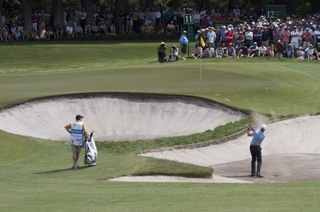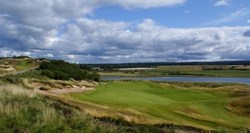When you come to think of it that is the secret of most of the great holes all over the world. They all have some kind of a twist. C.B. MACDONALD
Photos: Castle Stuart Saturday
/BBC Images From Castle Stuart
/ Thanks to reader Brian for this BBC image gallery of the Thursday scene at Castle Stuart and the Scottish Open. I arrive tomorrow and can't wait to see the course.
Thanks to reader Brian for this BBC image gallery of the Thursday scene at Castle Stuart and the Scottish Open. I arrive tomorrow and can't wait to see the course.
Here's Martin Dempster's Scotsman game story on Francesco Molinari's stunning opening round 62.
Q&A With Gil Hanse
/The 2012 Aberdeen Asset Management Scottish Open returns to Castle Stuart minus sponsor Barclays and hopefully minus freak thunderstorms that turned the crispy links into a mess that included a bizarre mudslide. Though the Gil Hanse-Mark Parsinen course will be much greener thanks to the UK's non-stop rains, Mother Nature will hopefully allow the Inverness, Scotland layout to be at its best.
The return provides an opportunity to make Hanse answer a few questions about the course and get a Rio Olympic course update (and full disclosure: I've worked on a number of design projects with Gil and hope to again in the future).
GS: Since being selected for the Rio 2016 Olympic commission, you've been back to Rio to walk the site and make modifications. How did that go and did it yield any significant deviations from your original plan?
GH: The site visits have gone very well. We are excited about the land, and the more time we get to spend on it, the more interesting the natural features we are finding appear to be. We shifted a few greens and tees around to take advantage of some natural features that we found, and also to reduce the amount of water that was green side on several of the opening holes. However, the routing stays much the same and the holes are roughly in the same configuration, the natural terrain for the "upper" holes is better than first imagined and those holes should be shaped right out of the existing landscape.
 GS: You will be visiting Australia soon for the first time for inspiration in the Rio design. What are you looking to learn there and why did seeing Sandbelt golf become a priority?
GS: You will be visiting Australia soon for the first time for inspiration in the Rio design. What are you looking to learn there and why did seeing Sandbelt golf become a priority?
GH: We have been very fortunate to have seen so many of the great courses in the world and to study their designs. However, neither Jim or I have been to Australia to study the great sandbelt courses. Having seen photos, and talked to people such as yourself about these courses, it seemed that we could draw a parallel to our site in Rio from a vegetation, sand, and topographical context to these courses. As a result, we feel it is imperative for us to travel down there and spend time on these great courses. Our good friends at Clayton/Ogilvy design have agreed to be our tour guides, so I am certain we will see some great architecture on the visit. We are hopeful that the configuration of their green complexes and the bunkering of the courses will be a fit for Rio, as will the reliance on short grass surrounds for the green complexes.
 GS: Castle Stuart hosts the Scottish Open for the second time, how big of an influence do you think it's success had on getting the Olympic commission?
GS: Castle Stuart hosts the Scottish Open for the second time, how big of an influence do you think it's success had on getting the Olympic commission?
GH: I believe that it had a significant influence on our selection for the Rio course. The selection committee made it clear that they were looking for a resume that included courses that have hosted significant tournaments. All of our other tournament course experience has been of a restorative or renovated nature, so to have an original design also be part of that submission was critical. The fact that the course was well received by the players, prior to the storm events, I believe had an impact on our selection.
GS: Last year's freak weather made it hard to fully judge the course, though players widely praised it and the use of a links style design prior to the Open. Yet there were many modifications made, can you enlighten us on those and whether you were consulted?
GH: Not sure if the modifications were in the "many" category but we did add some items to the course. As our co-designer on the course, Mark Parsinen, who is also the owner, was primarily in charge of coordinating these changes with the European Tour, based on their analysis and feedback.
 The primary feedback was that a couple of holes could use some tightening of the landing areas, so bunkers were added on the 5th and 14th holes, and several holes were lengthened. Interestingly enough, many of these additional tees were already constructed during the original design of the course. We built landforms for them, but grassed them in rough grasses, but we knew that we might need to add some flexibility to the length of the course if we were given the opportunity to host a championship. These new tees will be used if the wind conditions are appropriate for their use. We were consulted by Mark on these changes, and I think that they will have a minor influence on the outcome, we are just hoping for some good weather this year!
The primary feedback was that a couple of holes could use some tightening of the landing areas, so bunkers were added on the 5th and 14th holes, and several holes were lengthened. Interestingly enough, many of these additional tees were already constructed during the original design of the course. We built landforms for them, but grassed them in rough grasses, but we knew that we might need to add some flexibility to the length of the course if we were given the opportunity to host a championship. These new tees will be used if the wind conditions are appropriate for their use. We were consulted by Mark on these changes, and I think that they will have a minor influence on the outcome, we are just hoping for some good weather this year!
GS: As part of your studies as well as your time on site at Castle Stuart, you've spent a great deal of time in the UK and in particular in Northern Scotland. If someone were to plan a trip to see Castle Stuart and perhaps the new Trump course, could you give us a few lesser known links that are worth playing?
GH: Some of my favorites include Cruden Bay, Lossiemouth, Brora, and Fortrose and Rosemarkie, and Boat of Garten is a fun inland course. Of course any trip to this part of Scotland should include stops at Royal Aberdeen and Royal Dornoch, which is a masterpiece in my opinion.
AP: Rio Has No Contract With 2016 Golf Course Land Owner
/AP's Tales Azzoni reports that a court has ordered the city of Rio de Janeiro to hand over the contracts it has with the landowner of the 2016 Olympic golf course property. City officials responded by saying that no such documents existed.
The city said it hasn't signed any contracts for the golf course because it will be a private undertaking. It had publicly announced earlier this year, however, that it made an agreement with the land owner to have the course built on it. It said it would alter some of the building requirements in the area and, in exchange, the land owner and a construction company would pay for the $30 million course.
"The golf course is an undertaking exclusively private, which will be developed by the Rio 2016 Committee," the mayor's office said in a statement.
Local Olympic organizers said they expect the contracts for the golf course to be finalized by the end of June, and that the city wouldn't be directly involved even though it was responsible for choosing the land and facilitating the agreement.
And this...
But the lawyer for the company disputing the ownership of the land, Elmway Participacoes, said Friday he wants to suspend any activity in the land until a decision on the property is made. Sergio Antunes Lima Jr. said the city doesn't have the right to make any deals to build on the land before a judge decides who owns it.
Members Buy Boston Golf Club
/ Carol Britton Meyer of the Hingham Journal reports the good news that the members have saved Boston Golf Club from a possible outside purchaser, likely assuring the low-profile Gil Hanse design remains in its current rustic form.
Carol Britton Meyer of the Hingham Journal reports the good news that the members have saved Boston Golf Club from a possible outside purchaser, likely assuring the low-profile Gil Hanse design remains in its current rustic form.
There had been rumors that a certain developer known for his hair and buying distressed properties had looked at BGC as a possible acquisition.
State Of The Game Podcast, Episode 6: Gil Hanse
/"Why the darkhorse won the day"
/Analyzing The Rio Olympic Course Routing
/The T-Word Noticeably Absent In Dissecting Doral's Datedness
/Friday Photo Caption Fun: The Donald And Gil
/Golf Channel cameras picked up Donald Trump ratcheting up the greater Miami wind speeds by sharing suggestions with Gil Hanse for their 2013 redo of Doral. Or he's directing a plane into the gate. Either way, Gil isn't saying much, but what's The Donald saying?





The Donald Woos Golf Scribes With Hair, Gardening Talk
/Hanse's "Picturesque" Landscape Comment
/I noticed on comments here and in other discussion threads that a few folks stumbled when reading Gil Hanse's press release reference to a "picturesque landscape" for the Rio Olympic course design. It was not a frilly reference to golf course theatrics, but in fact, an homage to an aesthetic approach to landscape design espoused by figures like Humphry Repton, John Ruskin and Frederick Law Olmsted, and an influential philosophy on golf architects Alister MacKenzie and C.B. Macdonald.
If interested, you can read up about the picturesque school at Wikipedia.
And as for that picturesque landscape, it might be easier to visualize the Hanse design for the site by looking at this overlay of map and aerial photo posted on Hanse's site.











